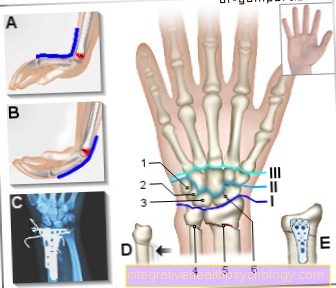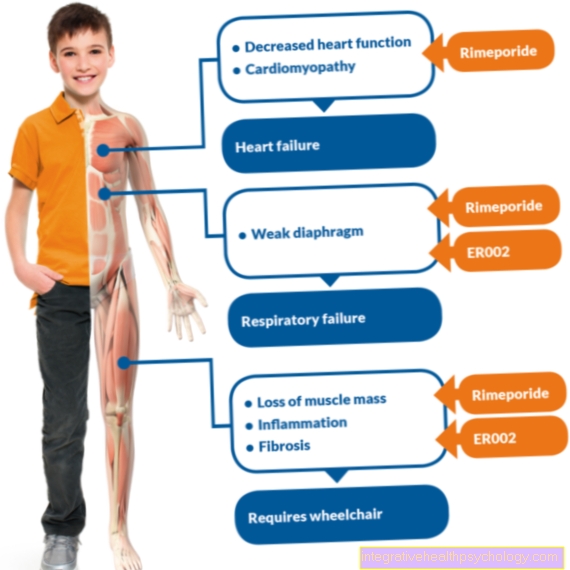Hepatitis A
Synonyms in the broadest sense
Inflammation of the liver, liver parenchyma inflammation, viral hepatitis, hepatitis A virus (HAV), infectious jaundice of virus type A, travel jaundice, travel hepatitis, liver runny nose
definition
Liver inflammation caused by the hepatitis A virus is a typical tourism disease. In most cases this is transmitted through contaminated water and food, especially mussels. In most cases, the symptoms are very discreet, so this form of viral hepatitis is also called liver flu. Hepatitis A never becomes chronic and can easily be prevented with a vaccination against the hepatitis A virus.

Pathogen and transmission
The hepatitis A pathogen belongs to the genus Picornaviridae, Genus Hepatovirus. These viruses are rarely found in countries with careful hygiene measures and good drinking water and food hygiene. In Southeast Asia, the southern European region (Mediterranean region), Russia, the Orient, Africa, Central and South America, the disease occurs more frequently and is often brought back to Germany from vacation.
The hepatitis A is a so-called Smear infectionwhose source of infection is the faeces of infected people (faecal-oral route of transmission). In particular through infected (contagious) water and uncooked seafood the hepatitis A virus is transmitted.
The hepatitis A virus
The hepatitis A virus (HAV) is the virus which leads to the disease of hepatitis A (HA) and causes 30% of all Hepatitis (Liver inflammation) applies. As a single-stranded RNA virus, it belongs to the Picornaviridae virus family (genus of the hepatoviruses). The virus measures 27nm in diameter and is very stable to temperature increases and disinfectants as well as other environmental influences. The virus is excreted in the stool in the bile.
Note: food intake
For the prophylaxis of a hepatitis A infection abroad, the following principle applies to food intake:
Cook it, boil it, peel it, or forget it!
But also through close contact with infected people The virus can be transmitted (including sexual, especially homosexual contact) and in rare cases through a transfusion of blood and blood products. The disease occurs more frequently in autumn and winter on. The Incubation, i.e. the period between infection and outbreak is between 14 and 45 days.
-> Read more about the causes of hepatitis A
Frequency / occurrence
Approx. 20% of all viral hepatitis are due to hepatitis A virus (HAV).
Around 2000 diseases are reported every year; However, since so many hepatitis A sufferers have no or only unspecific symptoms, experts assume an unreported number of around 10,000 or more cases.
Causes of Hepatitis A
The cause of hepatitis A (HA) disease is infection with the hepatitis A virus. The virus is transmitted to humans through the consumption of contaminated food, drinking water or objects contaminated with faeces. The infection cycle closes when the virus is excreted in the bile and stool and via the faecal-oral route of transmission.
Further information on the subject can be found here: Causes of Hepatitis A.
Routes of transmission and infection routes in hepatitis A.
Hepatitis A viruses are mostly transmitted fecal-orally and only very rarely via the blood (e.g. by a transfusion). Usually it is smear infections that spread the virus. Often through contact with stool containing viruses, contaminated drinking water or food and contaminated objects. Considered more precisely, this means for humans that inadequate hand hygiene, e.g. leads to the direct transmission of the virus to the oral mucosa after using the toilet. The virus can then enter the digestive tract unhindered. The transfer takes place enteral instead, translated it means via the intestinal mucosa. The digestive tract begins in the oral cavity and ends at the anus.
When the virus passes through the small intestine, it is absorbed into the bloodstream. From here it reaches the liver, which is primarily attacked and damaged by the hepatitis A virus. In rare cases, it can also be transmitted via the bloodstream if the infection is in the so-called Viremia phase is located. Viremia phase means the presence of the virus in the blood during the infection, usually for a certain period of time.
Transmission through kissing
Since a person infected with the hepatitis A virus excretes the virus through the stool, the virus is not transmitted through "classic" kissing. With adequate hand hygiene, the virus is very unlikely to be transmitted through kissing.
Risk of contagion / how long are you contagious?
In industrialized countries that have a high hygienic standard, such as Germany, infections with the hepatitis A virus are rather rare. Every year in the Federal Republic of Germany there are around 30-40 new cases per 100,000 inhabitants. From the age of 50, 50-60% of the German population are infected with the hepatitis A virus. Due to the low infection rate in industrialized countries, some children and young people are without natural immunological protection, since no antibodies are formed without infection or vaccination. 50% of all hepatitis A infections in Germany are acquired through vacation stays in southern or eastern Europe.
The hepatitis A infection is one of the so-called tourism diseases, as it is transmitted due to poor hygienic conditions (especially in developing countries) (primarily in Eastern Europe, tropical countries and the Mediterranean region).Infection occurs above all when the hygienic conditions do not meet the required standard. Particular caution is required at public toilets and camping sites. The problem is that the hepatitis A virus is very resistant to acids and alkalis and can withstand high temperatures. Not only travelers are particularly at risk, but also medical staff, workers in the catering and food industry, workers in refugee camps and residents of psychiatric facilities.
Children in the first year of life can shed the virus for a few weeks and thus infect others (especially siblings and parents). Otherwise there is a risk of infection between one to two weeks before occurrence and up to one week after the end of the icteric stage.
Incubation period in hepatitis A.
The incubation period is the time between infection with the pathogen and the appearance of the first symptoms. With the hepatitis A virus, this is about 2-6 weeks. This follows the incubation period Prodromal stage. The prodromal stage is the period of time in which signs or early signs of symptoms occur, which are typical but rather unspecific for the disease and can also be an indication of other diseases. That can depend on that icteric stage connect, which is characterized by the yellow coloring of the dermis of the eyes and skin.
Duration of illness
The classic course of the disease (after the incubation period) lasts 2-4 weeks, in rare cases it takes 3-4 months for complete healing. After infection, the hepatitis A virus multiplies in the human body for about one to two weeks. During this asymptomatic phase, the virus can be excreted in the stool and passed on to other people. The immune defense becomes active. Here, liver cell tissue can perish and the classic picture of liver inflammation (hepatitis) arise. Accompanied by one Jaundice (Yellowing of the skin). In the meantime, antibodies are produced by the immune system, which will ensure lifelong immunological protection. In 25% of cases, the infection can be completely symptom-free. In children, the disease is usually clinically silent.
Symptoms of hepatitis A.
The early symptoms (Prodromi) a hepatitis A infection are very unspecific and can be mistaken for the flu. Those affected feel badly exhausted, develop a fever, diarrhea accompanied by nausea, vomiting and a feeling of fullness. After a few days, specific symptoms may appear, including Indicate that the liver is affected. Like the yellowish / brownish discoloration of the skin and dermis of the eyes - in technical terms Jaundice / icteric stage called. The stool may turn a lighter color than usual, while the urine may turn dark because the bile pigments, which are normally removed with the stool via the bile, are released into the blood. Although these symptoms are typical of hepatitis A, they are not obligatory. Pain in the right upper abdomen and tenderness on the liver may occur. In adults, hepatitis A can be completely symptom-free in 25% of cases. The higher the age of the patient at the time of the initial infection, the more severe the symptoms.
More information can be found here: Symptoms of Hepatitis A.
Note
Chronic courses of hepatitis A are not known!
The Contamination in Germany the under 50-year-old is only 5%, while the population over 50 years is immunized in up to 90% of the cases. The cause lies in the lower hygiene standards in earlier times, so that many older people became infected with the hepatitis A virus in childhood.
In Germany around 50 percent of those infected with hepatitis A are Tourists from southern travel countries. The rest are infections in Community facilities, like kindergartens.
But also in Germany it happens again and again through imported hepatitis A infections minor local outbreaks (Epidemics). The viruses are either included in the kindergarten or passed on to the food by infected employees in businesses such as butchers and bakeries.
diagnosis
In the patient interview (anamnese) the pioneering symptoms and causes can be ascertained or other causes can be excluded. Specific questions can be asked about vaccinations against hepatitis A or about recent trips abroad. In the physical exam, acute hepatitis A often involves painful pressure right upper abdomen and a tactile one Enlargement of the liver on.
Parameters can be collected in the blood that indicate inflammation of the liver. The Liver enzymes (Transaminases or "liver values") GOT (Glutamate oxaloacetate transferase or also ASAT = Aspartate aminotransferase) and GPT (Glutamate pyruvate transferase or ALAT = Alanine aminotransferase) are located in a liver cell in different cell organelles. When liver cells are destroyed, these and other enzymes are released and can be detected in the blood. Depending on the constellation of the enzymes, the extent of the liver cell damage can be traced
The first possibility to secure the diagnosis by means of a blood test is about 14 days after the infection, since then the first antibody against the hepatitis virus A are produced by the body. These are the antibodies of Immunoglobulins M (IgM). IgM is an immunoglobulin that is the earliest antibody in the course of a Immune response (body's own defense reaction) is produced. An increased IgM antibody level indicates a acute Infection by HAV. A few days later, the B lymphocytes or plasma cells become permanent Immunoglobulin G (IgG) educated. These are the most important antibodies with the strongest defense effect, which, second after IgM, increase in number in the blood and fight the infection. Once the infection has been overcome, they are permanently detectable in the blood and in the case of hepatitis A they guarantee one lifelong immunity.
A proof of Virus DNA in the stool of the infectious patient is also possible for diagnosis.
Sonography:
At a Ultrasound examination the abdomen (abdomen) and the abdominal organs depicted with the help of ultrasonic waves. The transducer emits ultrasound waves that are absorbed or reflected by the various tissues it encounters. The transducer receives the reflected waves, which are converted into electrical impulses and displayed on a screen in different shades of gray.
When symptomatic acute Hepatitis A can affect the liver enlarged his and something lower echo appearing (i.e. darker) due to build up of fluid in the liver (edema). Sonography is not used to make a diagnosis but can be helpful in assessing the extent of the disease of HAV.
Changes in laboratory values in hepatitis A
If the liver is attacked by a hepatitis A infection, there is an increase in the so-called Transaminases. Transaminases are enzymes and accelerate important reactions in the conversion of amino acids. They are in large numbers i.a. localized in the cells of the liver and develop their effect here. If liver cells are destroyed, as in inflammation of the liver, these enzymes are released into the blood. If, in addition, newly formed antibodies (IgM class) against hepatitis A viruses can be detected in the blood, these, in combination with the changes in laboratory values, are proof of a hepatitis A infection.
Further information on the subject can be found here: Liver values
IgM in hepatitis A
In acute infections that an organism experiences for the first time, certain, specific antibodies against the virus that has penetrated are produced. IgM means immunoglobulin of type M, which represents an antibody that is only formed during the initial infection. These can fight the virus, while the body forms IgG-type antibodies at the same time, which will provide a more targeted and more effective defense if the virus attacks the body again. If antibodies of the type IgM occur in a hepatitis A infection, the person concerned knows that his body is infected with an acute infection. Approx. No more immunoglobulins M can be detected 4 months after the initial infection.
IgG in hepatitis A.
Immunoglobulins of the IgG type are the specific antibodies that grant the organism lifelong immunological protection against a certain antigen. They are formed during the initial infection with the virus and continue to circulate in the blood from the 6th week after infection.
therapy
Treatment of harmless hepatitis A is not necessary in most cases. A light diet, bed rest, and general hygiene measures to protect the area from infection are the general measures. Patients with fecal incontinence should be isolated over the infectious period.
Note: hygiene
A very simple but important hygiene measure is the thorough hand washing of those affected and their carers!
The most important thing in therapy is the elimination of additional liver-damaging substances. That means an absolute Alcohol leave, as alcohol can make the clinical picture much worse. This also applies to Medicationthat have a possible liver-damaging effect. In the very rare case of fulminant liver failure, the Liver transplant become necessary.
What can be the consequences of a hepatitis A infection?
In rare cases, a hepatitis A infection can develop more quickly and more seriously than usually. In the case of alcohol and / or drug abuse, or in the case of previously damaged liver cells, the healing phase can take longer. Triggered by the destruction of liver cells in one hepatitis In severe cases, a hepatic coma can follow. This can lead to liver failure. However, this is very rarely the case.
Cirrhosis of the liver in hepatitis A.
In cirrhosis, there is an increase in connective tissue and the destruction of the physiological organ structure. This leads to a reduced performance of the liver. This can no longer fully fulfill its tasks, whereby its most important task of freeing the body from foreign and dangerous substances is lost. The most common cause of liver cirrhosis is alcohol abuse, followed by infection with viral hepatitis, mostly through chronic infections. In the case of hepatitis A, cirrhosis of the liver only occurs in a few exceptional cases.
Can hepatitis A be chronic?
There is no chronic hepatitis A. It can also be completely symptom-free and can only be detected when an antibody titer is determined. Which then proves that an infection with subsequent immunization must have taken place. However, a hepatitis A infection can have two phases or persist for a longer period of time. Sometimes an infection occurs extremely quickly and then very violently.
Can hepatitis A be fatal?
In a healthy person who is not at particular risk, a hepatitis A infection heals completely and then receives lifelong immunological protection. In approx. 0.5-2% of the cases a fatal outcome is seen from a hepatitis A infection. Patients with chronic liver diseases, such as chronic hepatitis B or C, are particularly at risk, as an additional HAV infection puts a great deal of extra strain on the liver. In principle, all patients who are at health risk should be vaccinated if they are exposed to the hepatitis A virus and also given an immunoglobulin preparation in order to avoid major complications.
Prophylaxis / immunization / vaccination
In order to avoid a virus infection of the liver, vaccination against hepatitis A should be carried out as a precaution. This active vaccination is usually given as a combination vaccination with the hepatitis B vaccine. The body forms specific antibodies against the dead vaccine (killed viruses in the vaccine) and guarantees vaccination protection of 90-95% in the first 5 years. The immunization must be refreshed after approx. 10 years. The vaccination is indicated for planned trips to countries with a high incidence of hepatitis A. In addition, vaccination is mandatory for medical staff and sewer workers.
For the primary vaccination, two injections are necessary within approx. 12 months. Two to four weeks after the first vaccination, the protection is already very reliable, but only the refreshment after six to twelve months ensures reliable long-term protection.
Passive vaccination is also possible, in which immunoglobulins are injected intramuscularly (IM). They are obtained from the blood of infected patients and processed into a highly purified vaccine. This vaccination is carried out less often, but it is indicated when quick protection is necessary (for example, in the event of an unplanned trip to a country with a low hygiene status). Passive vaccination can also be used if there has been contact with an infected person. However, this is usually not fully effective because the infection has already taken place. The effect of passive immunization lasts only a few weeks.
Also read on this topic:
- Twinrix®
and - Vaccination against hepatitis A
Side effects of vaccination
Side effects of a hepatitis A vaccination occur in about 4% of vaccinated patients, which usually occur within the first three days. This can cause redness, swelling and pain at the injection site. About 10% of the vaccinated suffer from gastrointestinal disorders, mild fever, increased sensitivity to cold, headache and body aches. In rare cases, the levels of liver enzymes in the blood may rise. Neurological abnormalities or blood clotting disorders only occur in extremely rare cases. Sometimes allergic skin reactions can occur, which show up as a rash.
Is there a reporting requirement for hepatitis A.
The Infection Protection Act (IfSG) of the Federal Republic of Germany specifies (with the background of the epidemic situation) which diseases and pathogens have to be reported. Section 7 of the IfsG states that infection with the pathogen hepatitis A virus must be reported. Section 6 of the IfsG, which specifies the obligation to report diseases, states that acute viral hepatitis of any kind must be reported. This must be reported to the treating doctor or the laboratory that provides the evidence.





























